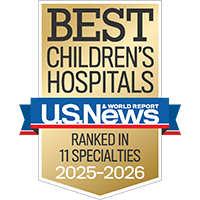Stress-free visits
Accommodations. Admissions. Procedure prep. Get the info you need for smoother hospital stays.
Prepare for your child's stay

Sickle cell anemia is an inherited blood disorder that causes blood cells to become hard, sticky and shaped like a sickle or "C." As a result, while traveling through the blood vessels, cells may become stuck and block the flow of blood throughout the body. This may cause a variety of symptoms and medical problems, including bacterial infections, pain, tissue damage, stroke and anemia. Blocked blood flow also can cause damage to the spleen, kidneys and liver.
Normal red blood cells are smooth, donut-shaped and contain hemoglobin A, which helps red blood cells transport oxygen through the blood vessels to the body. People with sickle cell anemia have red blood cells that contain hemoglobin S, an abnormal type of hemoglobin that causes the sickle shape change.
An estimated 70,000 people in the United States have sickle cell disease and 1,000 babies each year are born with the condition. It affects primarily people of African descent as well as fewer numbers of those of Portuguese, Spanish, French Corsican, Sardinian, Sicilian, Italian, Greek and Turkish descent. The disease also appears in Cypriots and those from Middle Eastern countries and Asia.
To request an appointment, give us a call: (877) 822-4453
Children with sickle cell anemia may develop a variety of related symptoms, ranging in severity. And while some children with the condition are usually healthy, others may experience frequent problems, including:
More than 40 states in the United States screen newborn babies for sickle cell anemia. Early diagnosis and treatment can prevent some of the complications of the condition. Studies have shown that early treatment dramatically reduces the risk of infections caused by sickle cell anemia and associated deaths in children with the condition.
In addition, prenatal tests are available to determine if a baby will have sickle cell disease or sickle cell trait, an inherited condition in which both hemoglobin A and S are produced in the red blood cells, always more A than S. Sickle cell trait is not a type of sickle cell disease, but means that a person is a carrier of the sickle cell gene. People with sickle cell trait are generally healthy and the trait cannot turn into the disease. However, when two people with sickle cell trait have a child, their child may inherit two sickle cell genes — one from each parent — and have the disorder.
Couples planning to have a baby can have a simple and painless blood test to determine their type of hemoglobin to see if they have sickle cell trait or a form of sickle cell anemia. Genetic counselors are available to discuss the results of the test and the likelihood of a couple's child having sickle cell trait or disease.
People with sickle cell anemia who live in the United States have an average life expectancy of 45 years. There are a variety of effective medications available to help reduce complications and improve survival.
Early treatment of newborns includes penicillin, vaccination against pneumococcus bacteria and folic acid supplementation.
Standard treatments for complications of sickle cell anemia include antibiotics, pain management, intravenous fluids, blood transfusion and surgery.
Hydroxyurea is a new treatment for sickle cell anemia that reduces the frequency of pain episodes, acute chest syndrome and the need for blood transfusions in adults. Studies are currently underway to determine the proper dosage of hydroxyeurea for children. Researchers also are investigating similar drugs for children to reduce the number of complications and improve survival, as well as new approaches to gene therapy.
Until recently the only cure for sickle cell disease was through a bone marrow transplant, (BMT) in which a patient receives healthy bone marrow from a sibling, or less frequently, umbilical cord blood. Bone marrow produces the stem cells that can become red blood cells. When the transplant works, the patient stops producing the sickle-shape red blood cells that give the disease its name and instead makes only healthy ones. However, most children with sickle cell disease don't have a sibling who is a good genetic match. In addition, a BMT is a risky procedure and doesn't always work.
Two new gene therapy treatments promise a better chance at a cure. Though they work in different ways, both can lessen or even eliminate the signs and symptoms of sickle cell disease by changing the genes involved in the production of red blood cells. Each is a one-time treatment, custom-made for each patient, using the patient's own stem cells.
Lyfgenia inserts a functional version of the hemoglobin-producing gene into the patient's stem cells. Addition of the gene helps the body make anti-sickling hemoglobin, which can potentially reduce or stop painful vaso-occlusive events.
Casgevy works by editing a gene in the patient's stem cells so they produce high levels of fetal hemoglobin. This special type of hemoglobin, normally only produced by babies while still in the womb, carries oxygen more efficiently than adult hemoglobin. The added fetal hemoglobin dilutes the amount of sickle hemoglobin circulating in the bloodstream, reducing or ending the painful vaso-occlusive episodes.
Treatment with either Lyfgenia and Casgevy involves a process similar to a bone marrow transplant. Patients have to have high dose chemotherapy to destroy the faulty stem cells so they can be replaced with the modified ones.
The course of treatment is time-consuming. It takes up to six months to manufacture either drug. Patients have to be hospitalized while getting chemo before the drug is infused, and for several weeks after the infusion so their recovery can be monitored.
To be eligible for the treatments, patients must be 12 or older and have experienced severe vaso-occlusive episodes.
UCSF Benioff Children's Hospitals medical specialists have reviewed this information. It is for educational purposes only and is not intended to replace the advice of your child's doctor or other health care provider. We encourage you to discuss any questions or concerns you may have with your child's provider.
Transplantation of Clustered Regularly Interspaced Short Palindromic Repeats Modified Hematopoi...
The adverse event rate will be summarized using descriptive statistics, together with 95% confidence intervals where appropriate. No formal statistical hypothesis testing will be performed. Adverse events defined: failure of engra...
Recruiting
More about this study
Ranked among the nation's best in 11 specialties
Stress-free visits
